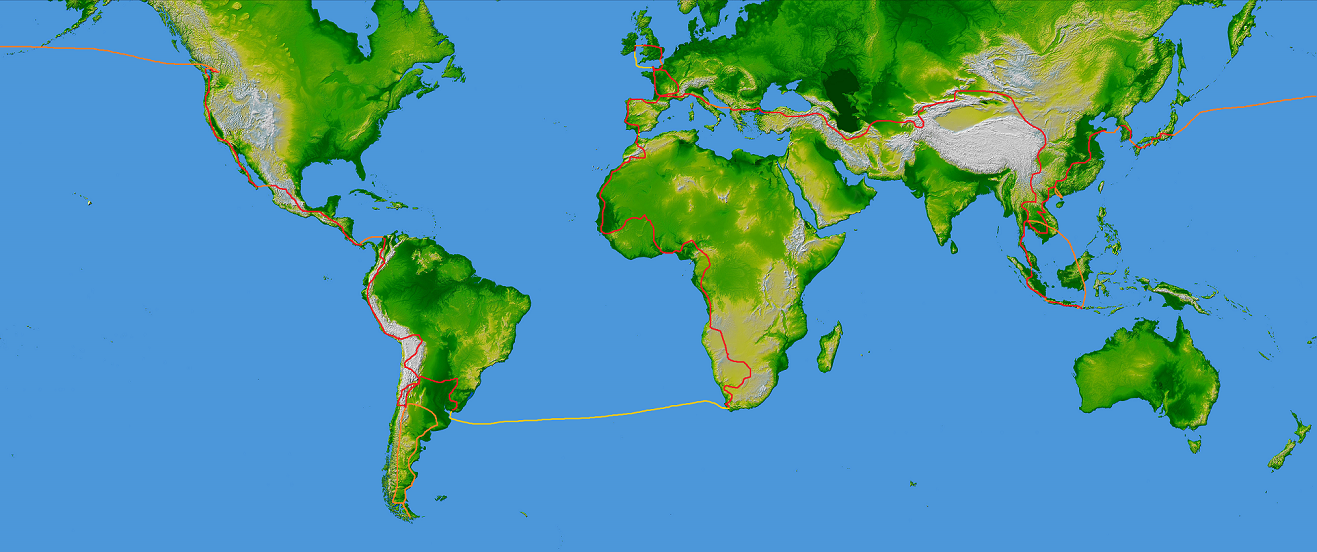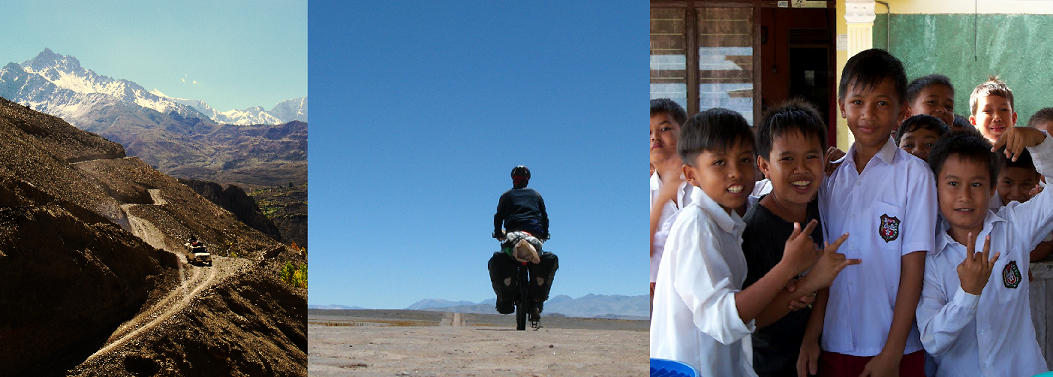Heinz Stucke's entry in the guestbook at Casa Amistad, Trujillo, Peru. Heinz left Germany in 1962 and has been pedaling ever since. Between 1962 and 2006 he rode 539,000 kilometres in 192 countries. He's still cycling...
The Casa Amistad (friendship house), the original Casa del Ciclistas in Latin America, has been providing a refuge for cyclists since the mid-80s when an Italian biking enthusiast living in Trujillo, northern Peru, began hosting passing cyclists. Already five guestbooks have been filled and I was guest number 1333. Lucho and his family have been managing the house for the past twenty years or so and as a former professional cyclist and a bicycle mechanic he provides invaluble support to those passing north or south along the Pan-American highway. I brought him the first ever Shimano chainring he had encountered that didn't fit the Shimano cranks I have but after much filing and reminiscing over the 2000 Tour de France and more filing, Rocinante had a new chainring. I spent two days wandering about Trujillo and making regular forays to the nearby market for plates of ceviche, a local dish of raw fish marinated in lemon or bitter orange juice.
Two Colombians, an Argentinian and an Irishman outside Casa Amistad...
leaving Trujillo, Peru 17th June
As I left Trujillo, Lucho warned me about one town, Paijan (pronounced pie-han), 50 km to the north along the Pan-Am highway whose young moto-taxi rogues appear to have developed a fondness for relieving passing cyclists of their belongings. Warnings become so frequent that one tends to dismiss them in order to maintain sanity and I had previously thought that Paijan was only a problem in the distant past, but recent entries in the guestbook at Casa Amistad proved this was not the case. Most problems have occured when cyclists have stopped in the town and then given time for a posse of young moto-taxi drivers to organise themselves and rob the cyclist on the outskirts of town. Lucho's advise was pretty simple. Don't stop. Ride very fast. To give more protection he called his friend there and arranged that I would phone him from the previous town and he would cycle with me through the town. The final strategy, which some cyclists have used with some success, was to have the police escort me out of town past the stretch where most of the robberies have taken place.
Rocinante outside the Casa de Ciclista in Chiclayo, Peru
So I said goodbye to Lucho and the other guests at Casa Amistad, passport and valubles buried deep in the four corners of Rocinante's panniers, apprehensive but confident that enough fail-safes had been put in place. At the first toll-booth on the Pan-Am, north of Trujillo, three smiling police officers motioned me to pull over and asked where I was from, where I was going and had Ireland made it to South Africa. Everyone with a passing interest in football seems to have heard of the France-Ireland qualifier and Henry's mano de dios and there was much sympathy. Without prompting they told me not to worry about the road ahead, everything was tranquillo and they would radio ahead to each of the police controls, which occured every few kilometres to let them know I was coming. In the town before Paijan, I called Lucho's friend but I was later than had anticipated and his friend was already in work. I told him not to worry, that the police seemed to be helpful and everything would be alright. I pedaled on towards Paijan, using my new mirror to watch the moves of moto-taxis and past a couple of more friendly police controls. The town of Paijan itself only lasts for about three kilometres along the highway and had it not been for Lucho's warnings would have appeared like any other Peruvian highway town, dusty and ramshackled but overall fairly friendly. Instead the whistles from groups of young mototaxi drivers lounging about on the roadside became aggressive and threatening in my mind. With a slight downhill and strong tailwind I cruised along at over 30 kph, overtaking mototaxis and weaving between buses. No smiles, no waves, just get me back in the desert please. On the outskirts a police car loomed into view ahead, the last police control. I pulled over and began the idle chat before asking the police to escort me out of town, as Lucho had told me to do. The chief of police had also told Lucho that cyclists should do this. The officers agreed it was a dangerous stretch of road but said they needed money for petrol if they were going to escort me. The one who was looking for petrol money began asking me about what I was carrying on the bike. Since there was evidence that in previous robberies, the police may have been acting together with the robbers, I was vague on details and again tried to drop names like Lucho's and the chief of police. Eventually they agreed they'd follow me out of town to make sure I wasn't followed by the mototaxis. As I rode on though, the jeep sat stationary and never followed me. A few kilometres out of town, I began to relax as Lucho had assured me that it was only on the immediate outskirts that the robberies had taken place. Ten, fifteen, twenty kilometres. On we rolled. Fifty kilometres later we pulled up at the nice surfing town of Pacasmayo.
Crossing the Sechura desert in northern Peru
While the rest of the world sat down and became engrossed in the World Cup I pedaled north towards Ecuador. From Chiclayo to Piura, lay a barren 220 km across the Sechura desert. This was luxury desert though, with restaurants every 20 or 30 km, serving filling almuerzos for about a euro and fridges stocked with an endless variety of cold drinks. On my final night in Peru I pulled up outside a police station that was sited on the beach about 65 km before the border crossing. I asked if I could pitch my tent. I was initially told this wasn't a hotel but after a few minutes of watching world cup highlights and asking about the trip, I was given a seat. Later I sat and watched as the three officers on duty set up a checkpoint outside the station and appeared to pull people at random off buses and taxis to check their IDs. Over a bowl of delicious fish soup that one of the officers had cooked that morning, I was told that things were much better in Fujimori's time, a sentiment I have often heard along the Pan-American about the former president's decade in office during the turbulent 1990s. He is currently serving a 32-year prison sentence for human rights abuses and embezzlement charges.
Things get green and sweaty in Ecuador
I crossed into Ecuador over the new Puente de la Paz and eventually found the poorly signposted migration office. Apparently bananas need passports too because as soon as the sandy, barren terrain of Peru ends, a tropical garden of Eden begins in Ecuador, with banana plantations lined up at the borderline like an invading army in wait. Klaus and his bicycle were standing outside the migration office and since we were both heading for Quito, we agreed to cycle together for the next few days. After a night in Santa Rosa we passed through the banana plantations around Pasaje. Del Monte. Dole. Household names at home and this is where it all starts. The surrounding villages and towns were pretty grim places really and I wonder what pay a worker on a banana plantation here receives. In the market Klaus bought ten bananas for 50 US cent, the US dollar being legal tender here in Ecuador since the collapse of the sucre. We began the climb out of the sweltering coastal lowlands as we turned east and headed for Cuenca and the Andean highlands. Halfway to Santa Isabel, however, and we had to load Klaus and his bike onto the back of a pickup truck as an infection in his leg was spreading and a nurse at a village clinic said he should go to the hospital in Santa Isabel. I continued climbing and by nightfall was just a few kilometres from Santa Isabel. I asked in a house on the roadside if I could set up home in their front yard. The friendly lady showed me to a place behind some trucks and offered me use of the outdoor shower and toilet, which was very much appreciated after the dodgy rice and chicken lunch that I had earlier in the day. The guard dogs were fairly sensitive to any movement, however, and were repeatedly breaking into hysterics during the night at any roll of the sleeping bag. I was sent off in the morning with a wave and a bunch of bananas.
Klaus
Failing to find Klaus the following morning in Santa Isabel but receiving his email that he had been treated and would be heading for Cuenca, I headed on for the last 80 km up to the highland metropolis. The third largest city in Ecuador and the suspected site of the mystical city of gold, El Dorado, Cuenca lies amid verdant green pastures full of milking cows at a pleasant altitude of 2500 metres. Getting here involved climbing some steep hills up past the mountain towns of Santa Isabel and Giron but 25 km before the city, the road leveled out and I was able to make it by nightfall yesterday.
Village in Ecuador, near Pasaje
Back into the Andes - climbing to Cuenca
Near Cuenca, Ecuador
Cuenca, Ecuador
Pedalled: 34,945 kilometres















